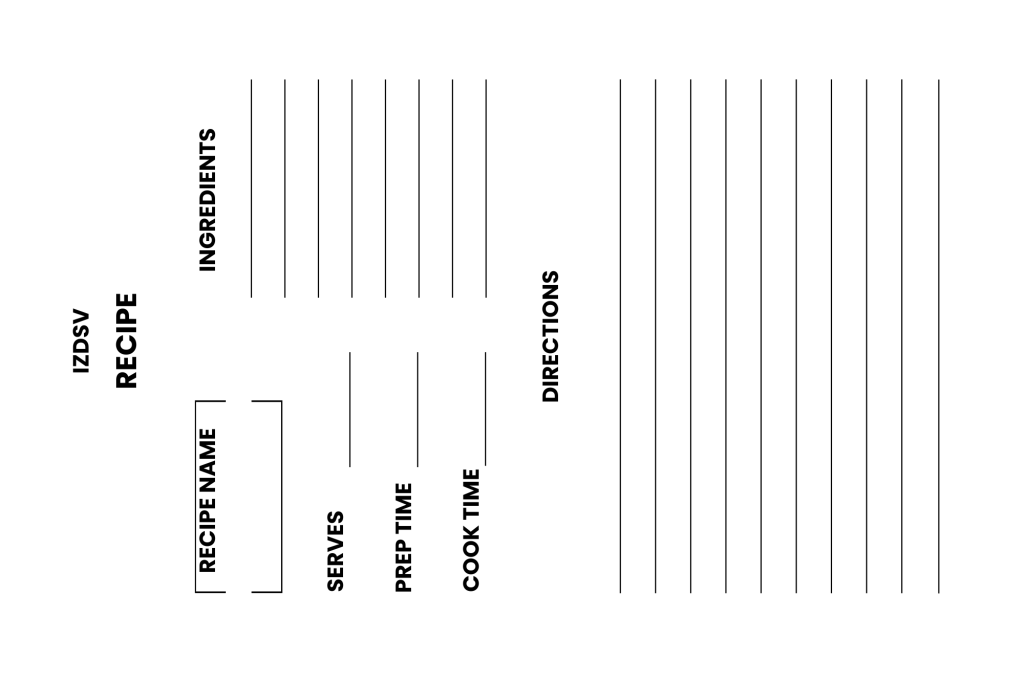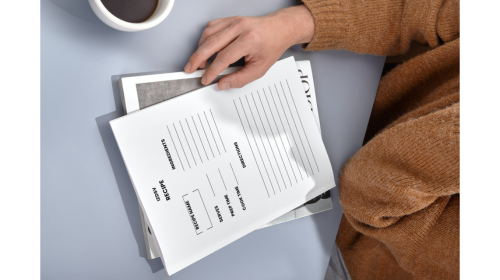From Kitchen Chaos to Order: Organize Your Recipes in a Printable Recipe Template
What is a Recipe Book Template?
A recipe book template is a pre-designed layout for organizing and presenting recipes in a structured format. It typically includes sections for ingredients, instructions, cooking time, serving size, and other relevant details.
Why Should You Use a Template for Your Recipe Book?
Using a template for your recipe book offers several benefits:
- Consistency: Ensures all recipes follow the same format
- Organization: Helps categorize and find recipes easily
- Professionalism: Gives your recipe book a polished look
- Time-saving: Eliminates the need to create a layout from scratch
- Completeness: Prompts you to include all necessary information
What Are the Key Components of a Recipe Book Template?
The key components of a recipe book template should be:
- Recipe title
- Ingredients list
- Step-by-step instructions
- Cooking time and temperature
- Serving size
- Nutritional information (optional)
- Space for notes or tips
- Category or cuisine type
- Difficulty level
- Preparation time
- Cooking equipment needed
- Image placeholder
How Can a Template Save You Time and Effort?
A template can save you time and effort by:
- Eliminates repetitive formatting tasks
- Provides a clear structure, reducing decision fatigue
- Ensures you don’t forget important recipe details
- Makes it easier to digitize and share recipes
- Simplifies the process of adding new recipes to your collection
What Sections Should Be Included in Your Recipe Book?
Sections to include in your recipe book should be:
- Introduction or Preface
- Table of Contents
- Appetizers and Starters
- Soups and Salads
- Main Dishes (potentially subdivided by protein type)
- Side Dishes
- Desserts
- Beverages
- Special Diets (e.g., vegetarian, gluten-free)
- Basic Cooking Techniques
- Measurement Conversions
- Index
How to Create a Table of Contents?
To create an engaging table of contents you should:
- Use clear, descriptive headings for each section
- Include subheadings for easier navigation
- Consider using icons or small illustrations to represent each section
- Use an easy-to-read font and consistent formatting
- Include page numbers for quick reference
- Consider color-coding sections for visual appeal
- Highlight special or favorite recipes
What Types of Recipes Should You Include?
Types of recipes to include in your cookbook template:
- Family favorites and heirloom recipes
- Seasonal dishes
- Quick and easy meals
- Healthy options
- Comfort foods
- International cuisines
- Special occasion recipes
- Dietary-specific recipes (e.g., vegan, low-carb)
- Basic staples (e.g., sauces, dressings, stocks)
- Trending or popular dishes
How to Organize Recipes: By Type, Ingredient, or Occasion?
There are several ways to organize recipes, and the best method often depends on how you typically search for recipes. Here are some options:
By Type:
- Appetizers
- Main courses
- Desserts
- etc.
Pros: Intuitive for most users, easy to navigate when planning meals.
Cons: It may be less useful for ingredient-based searching.
By Ingredient:
- Chicken dishes
- Beef recipes
- Vegetable-based meals
- etc.
Pros: Helpful when cooking based on available ingredients.
Cons: Can be confusing for mixed ingredient dishes.
By Occasion:
- Weeknight dinners
- Holiday meals
- Summer barbecues
- etc.
Pros: Useful for event planning, helps with contextual cooking.
Cons: Some recipes may fit multiple categories.
By Cuisine:
- Italian
- Mexican
- Chinese
- etc.
Pros: Great for exploring different culinary traditions.
Cons: May not be ideal if you prefer organizing by meal type.
Hybrid Approach: Combine two or more organizing principles. For example, organize primarily by type, but include tags or icons for ingredients, occasions, or cuisines.
Pros: Flexible and comprehensive.
Cons: Can be more complex to implement and navigate.
For products in the Recipes category click here
How to Design Your Recipe Book Template?
This is how you can design and customize your recipe book template:
- Start with a consistent grid system for layout
- Use white space effectively to avoid cluttered pages
- Create a hierarchy of information (title, ingredients, steps)
- Include space for photos or illustrations
- Ensure consistency across all pages
- Consider the book’s intended use (e.g., in the kitchen vs. coffee table book)
What Design Elements Make a Family Cookbook Visually Appealing?
Design elements for the visual appeal of your simple cookbook:
- High-quality food photography or illustrations
- Decorative borders or accents (used sparingly)
- Color-coded sections or recipe categories
- Icons for quick reference (e.g., vegetarian, gluten-free)
- Pull quotes for interesting facts or chef’s tips
- Textured backgrounds (subtle, not distracting)
- Infographics for techniques or nutritional information
How to Choose Fonts and Colors that Enhance Readability?
Choosing fonts and colors for readability:
Fonts:
- Use a clear, sans-serif font for ingredients and instructions (e.g., Arial, Helvetica)
- Consider a decorative font for titles, but ensure it’s readable
- Limit to 2-3 font families for consistency
- Use appropriate font sizes (e.g., larger for titles, smaller for notes)
Colors:
- Choose a color palette that complements food photography
- Use high contrast between text and background
- Consider color psychology (e.g., warm colors can stimulate appetite)
- Use color coding consistently for different sections or recipe types
- Avoid overly bright or neon colors that can strain eyes
What Layout Options are Best for Recipe Presentation?
Layout options for recipe presentation:
Single-page layout:
- All recipe information on one page
- Good for shorter recipes
- Easy to view at a glance
Two-page spread:
- Ingredients on the left, instructions on the right
- Allows for larger photos and more detailed instructions
- Good for complex recipes
Column layout:
- Divide a page into 2-3 columns
- Ingredients in one column, instructions in another
- Efficient use of space
Photo-centric layout:
- A large photo with recipe details overlaid or adjacent
- Visually appealing but may limit recipe length
Infographic-style layout:
- Visual representation of recipe steps
- Good for simple recipes or techniques
Card-style layout:
- Each recipe is presented as a “card”
- Great for digital formats or printable recipe cards
When designing your template, consider:
- Consistency across all recipes
- Ease of reading while cooking
- Space for notes or variations
How to Write Effective and Clear Recipes?
This is how to write effective and clear recipes:
- Use simple, direct language
- Break instructions into numbered steps
- List ingredients in order of use
- Be specific with measurements and temperatures
- Include prep time, cook time, and total time
- Provide clear descriptions of techniques
What Key Information Should Be Included in Each Recipe?
Key information to include in each recipe:
- Recipe title
- Brief description or background (optional)
- Yield (number of servings)
- Prep time and cook time
- Total time
- List of ingredients with precise measurements
- Equipment needed
- Step-by-step instructions
- Nutritional information (if relevant)
- Storage and reheating instructions
- Variations or substitutions
- Chef’s tips or tricks
How Can You Make Your Recipes Easy to Follow?
This is how you can make recipes easy to follow:
- Use active voice in instructions (e.g., “Chop the onions” instead of “The onions should be chopped”)
- Group related steps together
- Indicate when steps can be done simultaneously
- Use consistent terminology throughout the book
- Provide visual cues (e.g., “cook until golden brown”)
- Include prep steps (e.g., “Preheat oven to 350°F (175°C)”)
- Mention specific sizes of equipment when relevant
What Tips Can Improve the Clarity of Your Instructions?
Tips to improve the clarity of instructions:
- Start each step with an action verb
- Use short, clear sentences
- Avoid abbreviations unless they’re common and explained
- Include sensory cues (e.g., “until fragrant” or “until tender when pierced with a fork”)
- Specify exact quantities and times where possible
- Use parentheses for additional information or alternatives
- Explain unusual techniques or ingredients
- Cross-reference other recipes or techniques explained elsewhere in the book
How to Add Personal Touches to Your Recipe Book?
Adding personal touches to your recipe book can transform it from a simple collection of recipes into a cherished keepsake. How to infuse your cookbook with personality and meaning:
- Include a heartfelt introduction explaining the book’s significance
- Write brief intros for each recipe or section
- Add handwritten notes or sketches (or their digital reproductions)
- Include family photos alongside recipes
- Create themed sections based on family events or holidays
- Use personal rating systems or icons (e.g., family favorites)
What Personal Stories or Anecdotes Can You Share?
Personal stories or anecdotes to share:
- Origin stories of family recipes
- Memories associated with specific dishes
- Cooking mishaps or learning experiences
- How recipes evolved over time
- Special occasions where the dish was served
- Travel experiences that inspired recipes
- Childhood memories related to food
How to Include Family Traditions or Cultural Significance Into Your Family Recipe Book?
Include family traditions or cultural significance into your family recipe book by:
- Explain the role of certain dishes in family gatherings
- Describe how recipes reflect your cultural heritage
- Share the history behind traditional cooking methods
- Discuss how recipes have been adapted over generations
- Include sidebars with cultural facts or language translations
- Explain the significance of ingredients in your culture
- Share rituals or customs associated with specific meals
What Unique Photos or Illustrations Can Enhance Your Recipes?
Unique photos or illustrations to enhance your modern cookbook recipe template:
- Step-by-step photo tutorials for complex techniques
- Before-and-after photos of recipe stages
- Vintage family photos alongside modernized recipes
- Illustrations of family gatherings or cooking scenes
- Close-up shots of key ingredients or textures
- Photos of handwritten recipe cards or cookbooks
- Seasonal or themed backgrounds that reflect the recipe
- Illustrations of kitchen tools or cooking techniques
Ideas for visual enhancements:
- Create a family tree with photos and associated recipes
- Include a map showing the origins of family recipes
- Add pressed flowers or herbs from your garden as page decorations
- Include children’s drawings of favorite meals
- Create collages of food-related memorabilia (menus, tickets, etc.)




